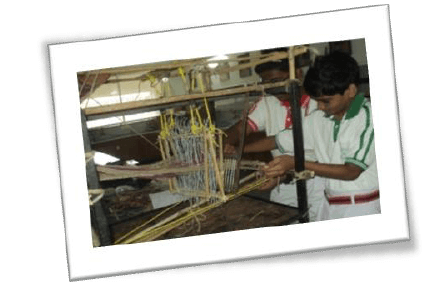Project Theme: Industry
Project Name : Coconut Husk Natural Fibers.
Abstract: In today’s fast paced world, the bridge between the haves and the have-nots is drastically increasing. Richer are getting richer and poorer are getting poorer. One of them is the weaving industry. Even though large machinery has automated the textile industry, the handlooms are still in great demand. Cottage industries are very popular in the coastal area of Kerala whereas states like Andhra Pradesh and Orissa are unable to tap these resources which include various natural fibres, mainly coconut husk.

Purpose served by the project
Empowerment – refers to the huge employmentopportunity provided by this initiative.
Easy and cost effective source of income for the rural population.
Eco – friendly products are manufactured which are the need of the hour.
Helps in the uplifting of the status of the rural folk.
The project even aids exports and imports which benefits the economical conditions of the country.
Reduces the use of artificial plastics in the society as they are non – biodegradable.
Even can be used to provide warmth to the body as it gives no irritation to the skin.
Even the residue during the process can be used a very good fuel.

Scientific Principle: Various simple machines are used in the model:
Pulley: It is a wheel on an axle that is designed tosupport movement of a cable or belt along itscircumference. Pulleys are used in a variety of ways to liftloads, apply forces, and to transmit power. The driveelement of a pulley system can be a rope, cable, belt, or chain that runs over the pulley inside the groove.
Class 1 lever: Fulcrum in the middle: the effort is applied on one side of the fulcrum and the
resistance on the other side, for example, a crowbar or a pair of scissors.
Class 2 lever: Resistance in the middle; The effort isapplied on one side of the resistance and the fulcrum islocated on the other side, for example, a wheelbarrow,a nutcracker, brake of a car etc. Mechanical advantage is greater than 1.
Method/Procedure followed: In the case of coconut:
At first, the fiber is removed from the coconut, and is spun into thick and long threads.
Then, these thick and long threads are loaded into the weaver.
After a certain period of time, pieces of cloth can be generated. In the case of our project :
Instead of coconut coir, jute is used (as jute is easy to handle and even the project becomesportable and compact.)
All the left out steps are done the same way.
Materials used:
- An old table – reused as the base frame
- Jute – as the fibre for the mat
- Bamboo Sticks – for levers
- Pulleys
- Fibre Thread – for various attachments
- Knife – for cutting and preparing brushes
- Metallic Grooves
- Handmade metallic loops + Wooden frame – for passage of fibre.
Name of the School: DAV Public School, Ramkrishanpuram, Hyderabad
